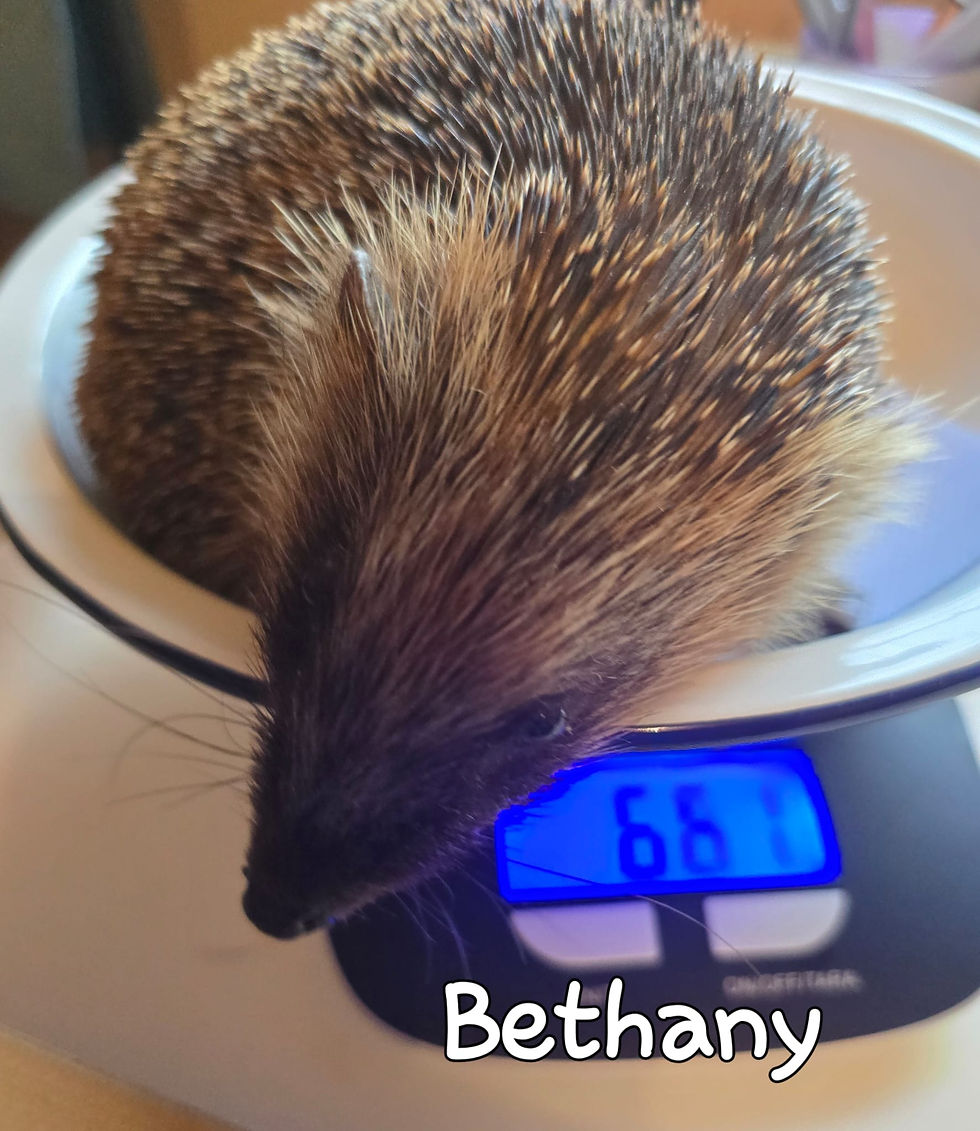Hedgehogs: The Prickly Gardeners You Didn’t Know You Needed
- Greg

- May 1
- 10 min read
Updated: May 6
Imagine a tiny, spiky vacuum cleaner bumbling around your garden at night, hoovering up slugs, snails, and other creepy crawlies that would otherwise be munching on your prize-winning lettuce. That, my friends, is the humble hedgehog—nature’s pest control and possibly the most adorable thing you’ll ever see waddling across your lawn.

I still remember the first time I saw a wild hedgehog up close—well, as close as I could get without being stabbed in the face. It was one of those nights from the time before: before responsibilities, before stinky nappies, before you had to think about things like how much sleep you were (not) going to get. My best mate Ant and I were stumbling home along Higher Lane in the not so early hours of the morning after a night at the Junction pub, somewhere between merry and sloshed, when we spotted it—this tiny, spiky explorer snuffling along the pavement, completely unbothered by our presence. Now, seeing a hedgehog is rare enough, but in our slightly worse for wear state, it felt like we'd just discovered a new species. Naturally, we did what any self-respecting people in their early twenties, in the early 2000's, would do—we stumbled and swayed quickly so we could to lay down on the pavement next to the poor thing to try and get a selfie.
It turns out, hedgehogs do not appreciate being the subject of impromptu photoshoots. The little guy very pointedly turned his back on us and snuffled away, disappearing into the nearest bush. So, while we didn't get our hedgehog group photo, we did get a valuable lesson: hedgehogs are adorable, but they are also deeply unimpressed by drunk humans. Ant also learned that people don't always pick up their dog poo from the path...

But hedgehogs aren’t having the best time of it lately. Their numbers have been declining at an alarming rate for decades—since the 1950s, the UK’s hedgehog population has plummeted from an estimated 30 million to less than a million today. That’s a staggering loss of over 97% in just a few generations. It’s not just a case of ‘Oh, there used to be more of them’—this is a full-blown crisis for one of Britain’s most beloved species. If we don’t step in, future generations might only know hedgehogs from Beatrix Potter books and nostalgic grandparents’ tales of ‘Back in my day, you couldn’t step outside without tripping over one!’ So, let’s talk about how we can help our spiky garden allies and why we should be rolling out the welcome mat (not literally, they’d just hide under it).
Why Are Hedgehogs Struggling?
Once upon a time, hedgehogs were a common sight in British gardens, trundling through hedgerows and snuffling through leaf piles. Now, thanks to habitat destruction, busy roads, and people being a little too obsessed with tidy gardens, they’re struggling to find food, shelter, and safe passage between green spaces.
Fences – Hedgehogs need to roam far and wide (up to two miles a night!) to find enough food. But solid fences have turned gardens into little islands, cutting them off from their usual routes. Even low gaps or small spaces at the bottom of fences can be vital to allow hedgehogs to move freely between gardens, helping them find food, mates, and new territories.
Slug pellets – People trying to protect their plants from slugs might accidentally be poisoning the very creature that naturally keeps slugs in check. Slug pellets contain metaldehyde, which is toxic to hedgehogs. When hedgehogs ingest slugs that have consumed these pellets, they too become poisoned, which can be deadly. Opting for natural methods to deal with slugs can help protect hedgehogs.

Roads – Hedgehogs are not built for sprinting, and their ‘curl up and hope for the best’ defence strategy does not work well against cars. Roads fragment their habitats, making it even harder for hedgehogs to safely travel between feeding grounds and nesting sites. Many hedgehogs fall victim to traffic accidents, particularly in areas where their routes have been cut off by urban development.
Loss of habitat – As we lose hedgerows and wild spaces, hedgehogs lose their homes. Urbanization, agricultural expansion, and the draining of wetlands have decimated the natural habitats that hedgehogs once thrived in. Without dense undergrowth or hedgerows for shelter, hedgehogs struggle to find places to nest and hide, particularly during hibernation.
Pesticides and herbicides – The widespread use of pesticides and herbicides in farming and gardening has led to a decline in the number of insects hedgehogs rely on for food. Insects such as beetles, caterpillars, and earthworms are vital to their diet, and when these populations decline, so do the hedgehogs. The chemicals used in these products can also harm hedgehogs directly when they ingest contaminated prey.
Climate change – Changing weather patterns have an impact on hedgehogs' ability to find food and shelter. Milder winters can disrupt their hibernation cycles, leading them to wake up too early and struggle to find food. On the flip side, harsher winters can be deadly for those that aren't able to build up enough fat reserves to survive.
Basically, we’ve made life pretty difficult for them. But the good news? It’s really easy to make your garden a hedgehog haven. Simple changes can make a huge difference to hedgehog populations. Every little effort counts towards giving them a safe and thriving environment.
Creating a Hedgehog-Friendly Garden
The good news is that hedgehogs aren’t picky. They don’t need luxury homes or five-star meals—just a few simple tweaks can transform your garden into the perfect haven for them to thrive.
Hedgehog Highways – Cut a hole about the size of a CD (roughly 13cm x 13cm for those too young to not know what a CD is) at the bottom of your fence to create a passage for hedgehogs. If your neighbour wonders why you're sawing into your fence at 10 pm, just shout “it’s all for a noble cause! The Snufflepigs need access!”
When we had our cats at our last house, they quickly found the hole we’d made in the fence and, much to their amusement, used it as an energy-saving shortcut for dragging pigeons into the garden. Instead of making a round trip through the entire garden, they’d pop through the hole with their prized catch, saving themselves a good bit of effort.
Ditch the Slug Pellets – Let the hedgehogs do the heavy lifting when it comes to slugs. Not only will they keep your garden slug-free, but you'll also avoid the mess of slimy remains. Plus, you'll get the satisfaction of knowing you're helping the local wildlife thrive.
Leave Wild Patches – That pile of leaves you’ve been meaning to clear up? Well, it’s actually prime real estate for hedgehogs looking for shelter. Let nature do its thing and create a perfect hiding spot for them. The more natural and untidy your garden, the better it is for hedgehogs (and other creatures too!).

Provide Water – A shallow dish of water can be a lifesaver, especially during hot spells. Just remember, no milk! Hedgehogs are lactose intolerant, and a gassy hedgehog is the last thing you want waddling through your garden, even if the image of a poddling fart machine is amusing. Water is key to keeping them hydrated and healthy.
Build a Hedgehog House – A simple wooden box tucked away in a quiet corner makes a cozy winter retreat for hedgehogs. It’ll keep them safe and snug through the colder months, giving them a warm, dry place to hibernate. You can also get some with a special entrance block or with a tight turn that prevents predators getting into them.
Basically, the messier your garden, the happier the hedgehog. So, now’s your chance to stop worrying about that “perfectly tidy” garden—let nature take its course! Plus, creating a haven for hedgehogs is a great way to add some wild charm to your space, while also offering a safe refuge for these prickly little creatures.
Feeding Hedgehogs (Without Accidentally Attracting a Local Fox Party)
If you want to offer some extra food to hedgehogs, it's a lovely gesture, but make sure you’re feeding them the right stuff.
✔ Good options: Meaty cat or dog food (wet or dry), specialist hedgehog food, or crushed peanuts. These options provide the protein and nutrients hedgehogs need to stay healthy. You can also leave out some water for hydration.
❌ Bad options: Bread, milk, or mealworms. Bread is low in nutrients and can cause digestive issues, while milk (as mentioned before) is bad for hedgehogs as they’re lactose intolerant. Mealworms, despite their name, should be avoided—though they might seem like a tasty treat, too many mealworms can cause health issues, particularly with hedgehog bones. Think of them as the equivalent of junk food—tasty in moderation but definitely not a daily snack.

To avoid attracting the entire local fox and badger population to a midnight feast, it’s best to use a hedgehog feeding station. This is essentially a box with a small entrance, designed so that only hedgehogs can get in. Larger animals like foxes and badgers won’t be able to squeeze through, and the hedgehogs will have a quiet, safe space to enjoy their meal undisturbed. Plus, this way, you won’t be hosting an unwanted nocturnal party!
What to Do If You Find a Hedgehog in Trouble
Hedgehogs are one of the most charming creatures in our gardens, but sometimes, they need a little extra help. While they’re usually quite capable of looking after themselves, there are times when they may be struggling and need some human intervention. Here’s what you should do if you come across a hedgehog in distress:
1. Out in Daylight?
Hedgehogs are nocturnal creatures, which means they’re usually out and about during the night. If you spot one wandering around during the day, it could be a sign that something’s wrong. Whether it’s a sign of illness, injury, or simply struggling to find food, a daytime appearance can indicate trouble. If you see a hedgehog out in daylight, it’s best to call a local wildlife rescue group for advice on how to help. They can guide you on the next steps.

2. Too Small Before Winter?
Young hedgehogs, or “hoglets,” need to reach a certain weight (around 600g) before they can safely hibernate. If you find a small hedgehog in late autumn, it could be underweight and may not survive the winter without help. Wearing thick gardening gloves you can possibly weigh the hoglet carefully. If it’s under 600g, it’s best to get in touch with a wildlife rescue to see if they can care for it until it’s strong enough for hibernation.

3. Caught in Netting?
Hedgehogs are notorious for getting caught in garden netting or plastic, as they struggle to move backward. If you find a hedgehog tangled up, the first thing to do is carefully free it. Once freed, check the hedgehog for any injuries, such as cuts or scratches, and watch for signs of distress. If the hedgehog seems injured, you should contact a local rescue for further guidance.
4. Looking Sick or Injured?
If you find a hedgehog that’s wobbly, lethargic, or visibly injured, it needs help. Hedgehogs are great at hiding illness, so any signs of weakness or injury should be taken seriously. In these cases, contact a local wildlife rescue or rehabilitation center right away. They will provide the best care to ensure the hedgehog gets back on its feet.

Local Wildlife Rescue Centres in Merseyside:
If you find a hedgehog in need of help in the Merseyside area, there are some great local organizations that can provide support:
Freshfields Animal Rescue (Merseyside)
Freshfields Animal Rescue is a charity organization dedicated to rescuing, rehabilitating, and rehoming domestic and farm animals, as well as wildlife.
Contact: https://www.freshfields.org.uk/ | 0151 9311604
Lowton Hedgehog Rescue
The rescue takes in sick and injured hedgehogs from members of the public and local vets. We also hand rear hoglets that have been found without their mum due to abandonment or have been orphaned. The aim is to rehabilitate these animals to full health so that they can be released back to the wild. In 2023 a total of 790 hedgehogs came through the facility which is run with the help of volunteers and supporters. The rescue operates 365 days a year.
Contact: Email:irene.thomson@btopenworld.com | 07950 933410
Hindley Hedgehog Help
The charity collaborates with Irene of Lowton Hedgehog Rescue to provide care for ill or injured hedgehogs. Their mission focuses on rehabilitating these animals and ultimately releasing them back into their natural habitats. The organization has trained with Vale Wildlife Hospital, gaining expertise in hedgehog care, rehabilitation, and microscopy. They have also achieved The Wildlife Care Badge, which is awarded based on a knowledge assessment and a veterinary inspection of their facilities.
Contact: Email: juliasixsmith@gmail.com | 07812 688561
As a quick aside, I just want to thank Julia from Hindley Hedgehog Help for providing me with a bunch of pictures for this blog post. I'm very jealous that she gets to handle these marvellous critters so much. Thank you!
Hedgehogs Are Worth the Effort
At the end of the day, hedgehogs aren’t just cute, waddling garden ornaments. They’re a vital part of our ecosystem, playing a key role in keeping pests in check and helping to maintain a natural balance in our gardens. By munching on insects, snails, and slugs, hedgehogs help control the very pests that can destroy your plants, making them an invaluable (and adorable) asset to any garden.

Helping hedgehogs isn’t as difficult as you might think—it’s the same as almost anything needed to rewild your garden, it’s mostly about not doing certain things. Don’t obsessively tidy up your garden, don’t block their paths, and don’t use harmful chemicals like slug pellets or pesticides. If you take a few simple steps, such as leaving wild patches, cutting gaps in your fences, and providing a water source, hedgehogs will happily thrive in your garden.

In return, you get a natural slug deterrent (no more worrying about slimy invaders) and the sheer joy of spotting a spiky little visitor snuffling around at night, doing its part to keep your garden healthy.
So, let’s make our gardens a little more hedgehog friendly. After all, I’d hate to have to explain to my daughter what a hedgehog was because there aren’t any around anymore.
“So you’re telling me there was a cute-as-hell, shoe-sized creature covered in spines, snuffling around eating slugs, and you lot just let them vanish?"
No thanks. Let's save them while we still can, eh?
Got a hedgehog visiting your garden? Want to swap tips on hedgehog houses or share your best ‘hedgehog rescue’ story? Join the Rainford’s Rewilders Facebook group and let’s get hedgehogging!
Prepare yourself for a cuteness overload


















































Comments